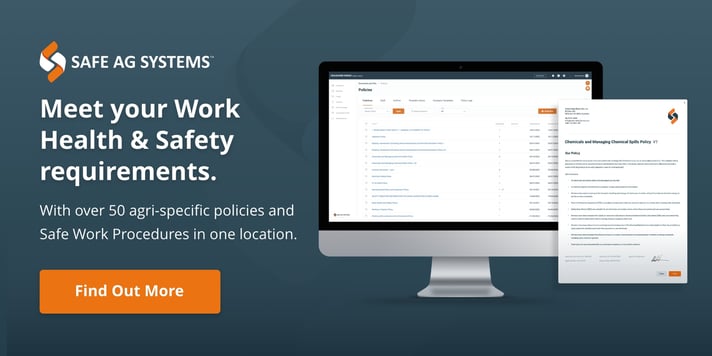Having work health and safety policies demonstrates your commitment to ensuring a safe work environment and to reducing health and safety risks for all workers, contractors and visitors.
Policies should be developed through consultation with your workers and usually outline the responsibilities of management and workers. It should also encourage cooperation and consultation between managers and their workers and outline how health and safety will be managed on farm.
In a farming environment, there are usually several policies needed to be written and maintained depending on the type of farm, machinery used, and many other factors.
But writing a policy does not need to be onerous or time-consuming – there are templates available which may require only a few modifications, or you may feel prompted by the template to draft your own relevant to your particular situation.
Download a Free Work Health and Safety template
Where do you start when it comes to policies?
Step One: Create a Work Health and Safety Policy.
This is an overarching policy which tells everyone what safety on your property is all about. It’s a good idea to consider your audience when drafting your policy. Think about your communication style and make sure it’s clear and direct.
Step two: Think about your daily operations.
Start to think about other things in your business where you need to provide some guidance to your workers and others. Start with your high risk tasks and some time to assess it.
As the name suggests, Risk Management is the process of managing and controlling risks within your agribusiness. But what are you actually doing if you are ‘managing risk’? The good news, it can be a simple process – just keep S.A.F.E.
S = See it. Identify the risks and hazards and things that could hurt someone.
A = Assess it. Think about what harm could come from the hazard, and how serious it might be.
F = Fix it. Put ‘controls’ in place to eliminate or reduce the risk.
E = Evaluate it. Did the controls work as you thought? This gives you a chance to tweak things to improve safety. Keep tweaking until you’re happy you’ve got things as good as possible.
Step three: Finally, document and communicate.
No matter what method you decide to use, paper or digital, make sure you communicate your expectations clearly.
What are some of the most used policies on Australian Farms?
Below is a list of some of the policies which may be required on-farm – as you can see, not all of these are relevant to every farm or every situation. Therefore, it is essential you develop your own policies. Here are a few suggestions:
-
Contractor on farm policy
-
Electrical safety policy
-
Fit for work policy
-
Golden rules policy
-
Manual handling policy
-
Operating machinery and equipment policy
-
Quad bike and motorbike policy
-
Remote and isolated work policy
-
Smoking policy
-
Work health and safety policy
-
Working at heights policy
-
Working in confined spaces policy
-
Working outdoors policy
-
Working with chemicals and managing a chemical spill policy
Start a Free 7-Day Trial of Safe Ag Systems
Why should I review or update my farm policies?
There are a number of reasons you should be regularly reviewing your health and safety policies; best practices, legislative changes, staff turnover and report findings are just a few reasons. These policies need to be effective to help reduce the financial risk to your business, but it doesn’t just help you to manage regulatory compliance and protect your workers. Your policies are a reflection of your business.
Other important reasons to start reviewing your policies:
- Supplier product updates or recommendations
- New equipment and processes
- An accident or near miss has occurred
- Recommended updates following worker consultation
How often should health and safety policies be reviewed?
Policies need to be reviewed from time to time, to make sure they still make sense and keep people safe.
- You must review them if there are any changes in the workplace (for example, you’ve bought a new bit of plant equipment and the safety risk has changed).
- You must make sure they comply with the law and any changes in legislation or regulations.
- You must also review policies and procedures “at regular intervals”. There is no hard and fast rule but policies and procedures around high risk work should perhaps be reviewed every couple of years, and low risk you might review in 4-5 years.
On a final note
What ever the timeframe you decide on, make sure you’ve documented it and why decided that. Put a review date on your policies and stick to it. It is also essential these policies have been read, understood and signed by your employees.
Topics: Safety Management System
Disclaimer: Content on this website may be of relevance to users outside of Australia, but content links and examples are specific to Australia. Please check with your local authority for your country and industry requirements.











